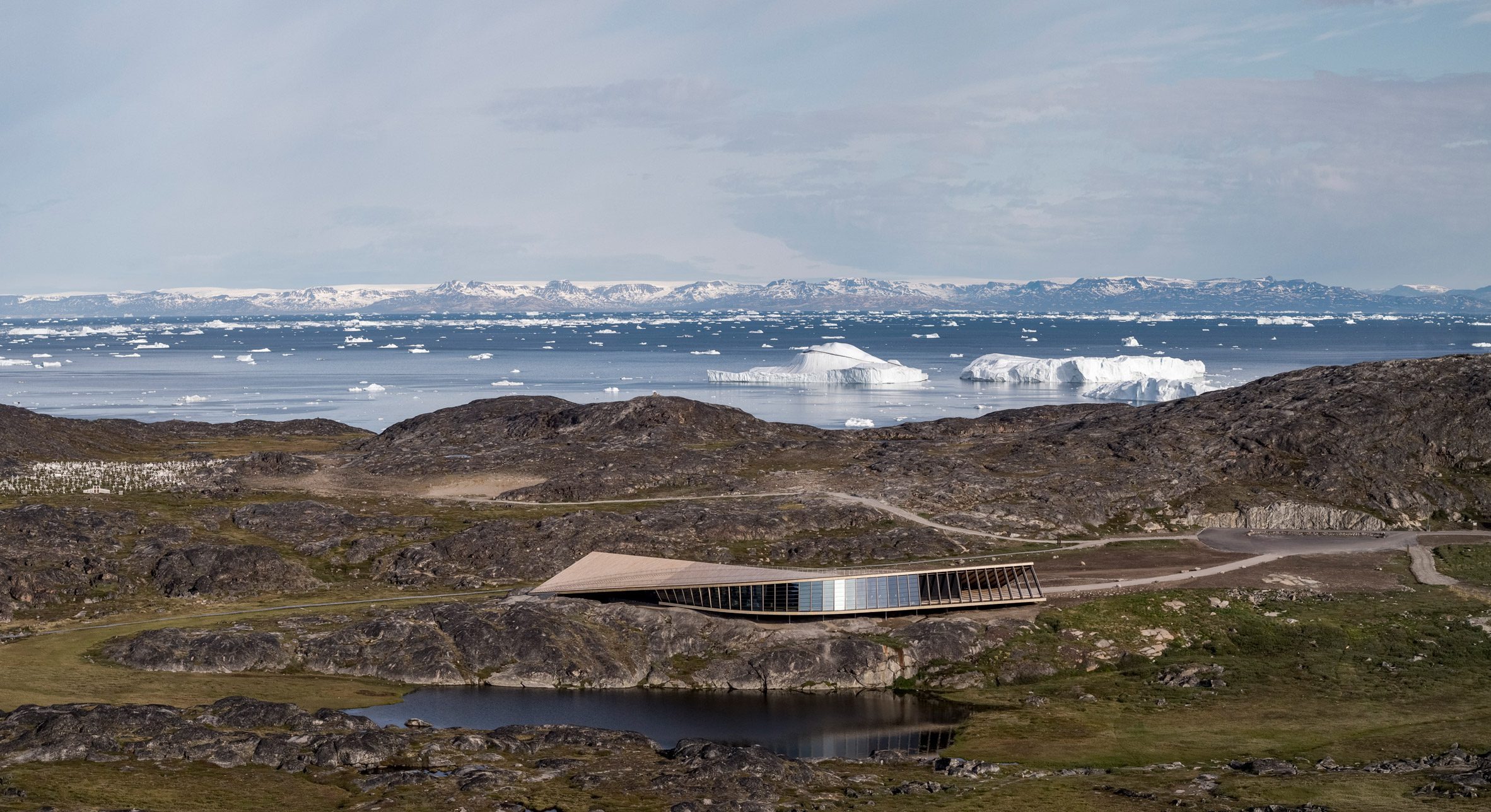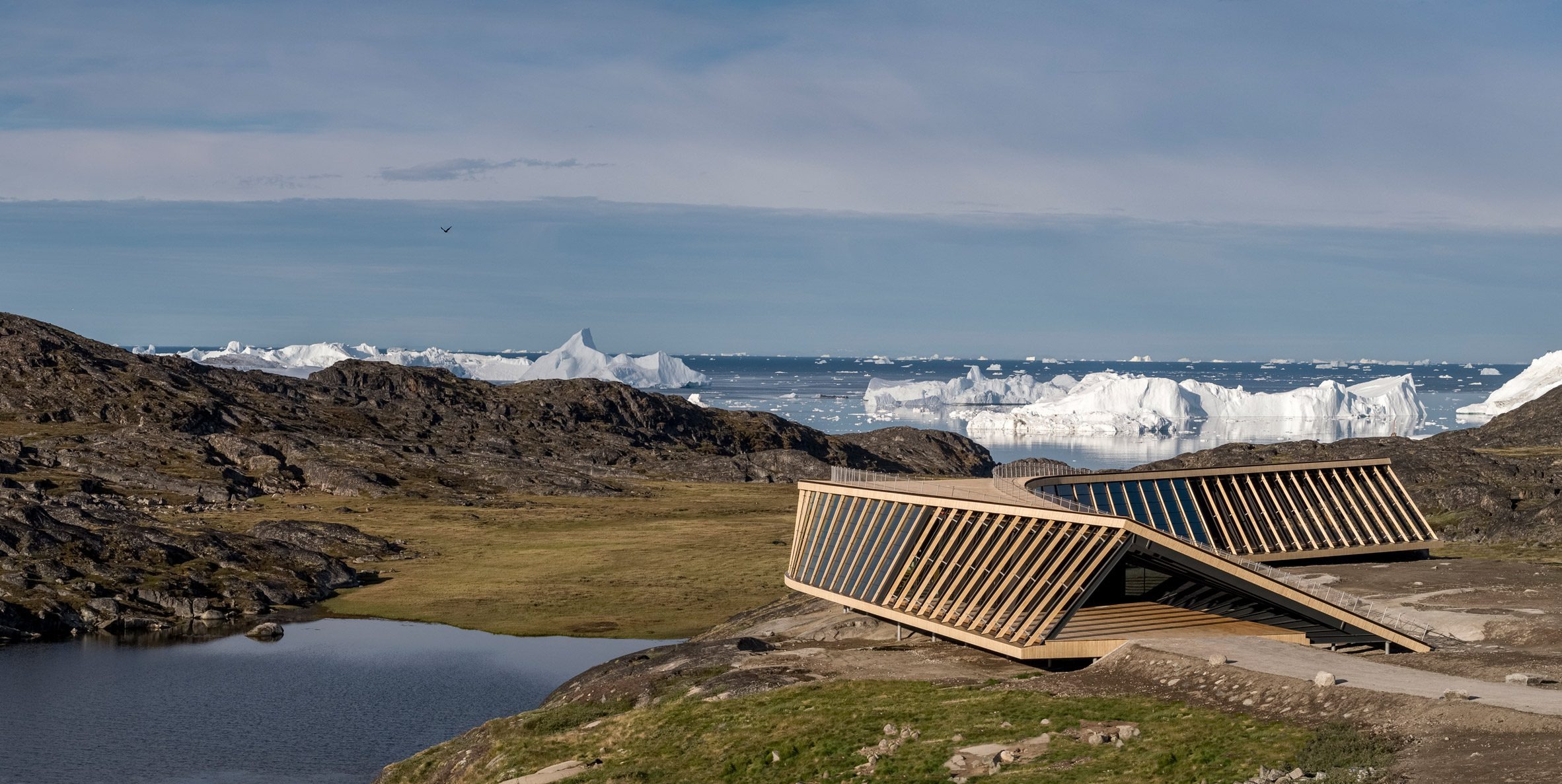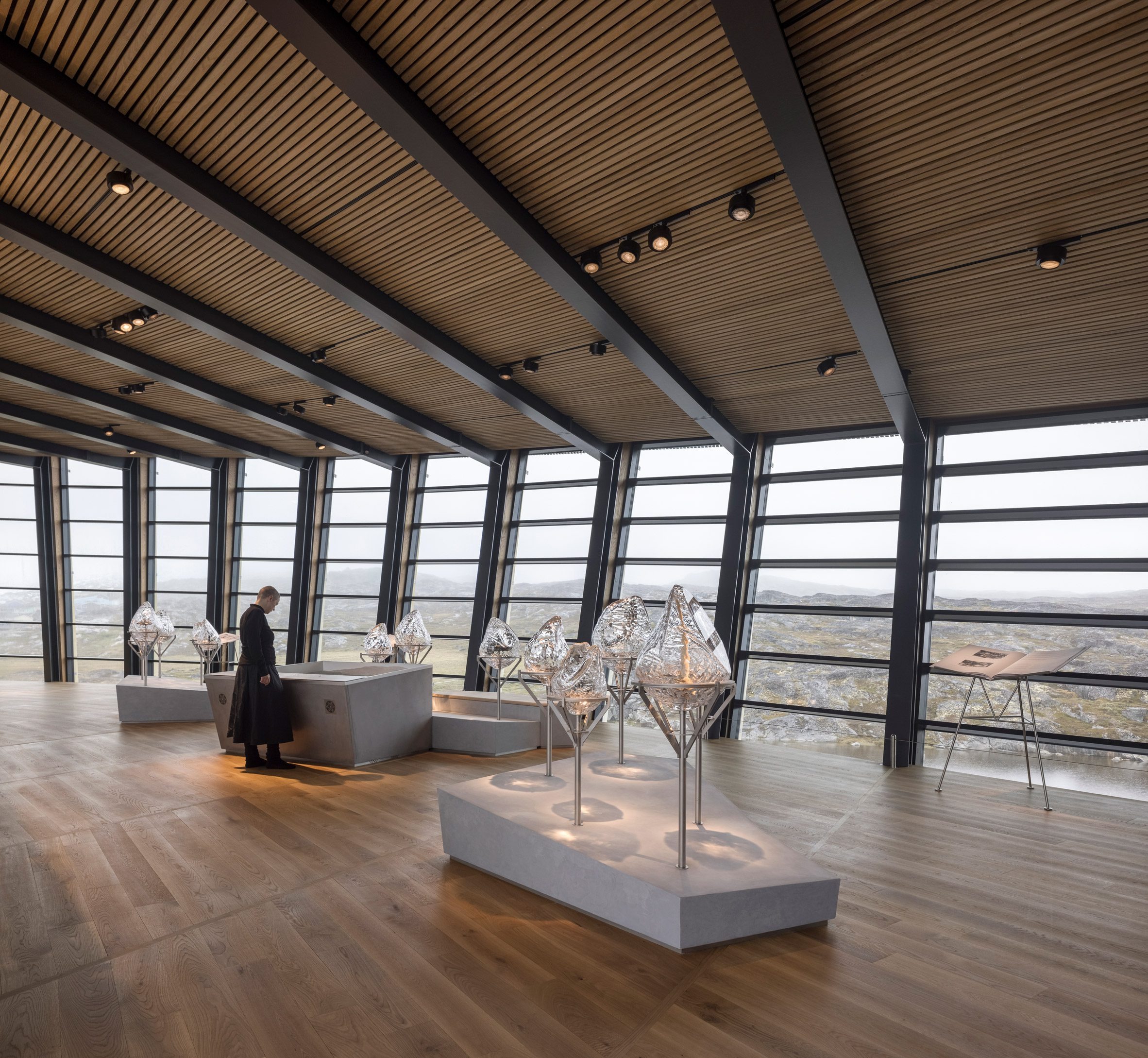"건축은 자연의 일부가 되어야 하며, 자연을 지배하려 해서는 안 된다."— 렌 머컷 (Glenn Murcutt)

극지 풍경 위에 내려앉은 건축 Dorte Mandrup completes visitor centre in Greenland
도르테 만드룹, 그린란드 일루리사트 빙하협곡 센터
I. 눈올빼미의 비행
북극권 250킬로미터 북쪽, 그린란드의 거친 암반 위에 하나의 건축이 자리한다. 덴마크 건축가 도르테 만드룹이 이끄는 Dorte Mandrup Arkitekter가 설계한 일루리사트 빙하협곡 센터다. 이 방문자 센터는 기후변화의 최전선에서 연구와 교육, 전시를 아우르는 지식의 허브로 기능한다.
건축가는 이 건물을 "풍경을 가로지르는 눈올빼미의 비행"에 비유한다. 비틀린 삼각형 구조는 점진적으로 회전하며 풍경 위를 미끄러지듯 지나간다. 이 형태는 단순한 조형적 제스처가 아니다. 경사진 지붕은 눈 쌓임을 방지하는 동시에, 보행 가능한 옥상 전망대로 기능하며 지역 하이킹 루트의 자연스러운 종착점이 된다.
"빙하협곡 센터는 극적인 풍경 속에서 피난처를 제공하며, 북극 황야의 무한하고 비인간적인 규모, 어둠과 빛의 전환, 한밤의 태양, 그리고 하늘을 가로지르며 춤추는 오로라를 경험할 수 있는 자연스러운 집결지가 되는 것을 목표로 한다." 만드룹의 말이다.
설계의 핵심은 명확하다. 건물이 개방적이고 가벼워 보이도록 하여, 방문자들이 압도적인 자연 앞에서도 풍경과 연결되어 있다고 느끼게 하는 것. 이 전망대에서 바라보는 Kangia 빙하협곡의 빙산들은, 건축이 제공하는 가장 강력한 전시물이 된다.
II. 자연을 건드리지 않는 구조
건물은 그 기능만큼이나 환경을 배려한다. 상당한 탄소발자국을 남기는 콘크리트를 최소화하기 위해, 설계팀은 강철 프레임을 구조 시스템으로 선택했다. 가벼운 강철 보가 암반에 최소한의 접점으로 건물을 고정하며, 구조물을 지면에서 살짝 들어 올린다. 이로써 건물 아래 공간은 여전히 식물과 야생동물의 서식지로 기능할 수 있다.
건물의 형태는 일련의 강철 트러스가 풍경을 가로지르며 점진적으로 곡선을 그리고 회전하면서 생성된다. 이 시퀀스가 특유의 비틀린 형태를 만들어내며, 지붕 위의 눈 쌓임을 구조적으로 해결한다. 형태의 논리와 환경의 조건이 하나의 해법으로 수렴하는 지점이다.
비틀림은 또한 예상치 못한 가능성을 연다. 경사진 지붕 위를 걸을 수 있게 되면서, 이 건축은 새로운 공공 공간을 생성한다. 극지의 풍경 속에서 옥상은 단순한 지붕이 아니라, 공동체가 모이는 광장이 된다. 건축가는 이곳이 6주간의 극야 끝에 해가 40분간 떠오르는 1월, 마을 사람들이 모여 태양을 축하하는 장소가 되기를 바란다.
III. 빛과 얼음의 서사
이 건축적 무대 위에서 펼쳐지는 것은 얼음의 서사다. 내부 공간은 사방이 유리로 둘러싸여 있으며, 지붕 아래에는 보호된 야외 테라스가 자리한다. 설계의 의도는 명확하다. 그린란드의 극적인 조명 조건을 온전히 경험하게 하는 것.
"그린란드에서는 여름에만 일광이 있습니다. 겨울에는 매우 어둡지만, 눈과 땅으로부터의 반사가 있습니다. 여름에는 빛의 색이 매우 다릅니다. 한쪽에는 푸른 빛이 있고 다른 쪽에는 매우 붉은 빛이 있습니다. 건물을 통과하며 이동할 때 그것을 경험하기를 바랍니다." 만드룹의 설명이다.
센터는 이제 대중에게 개방되어 있으며, 전시 갤러리, 영화관, 연구 및 교육 시설, 카페, 상점을 갖추고 있다. JAC Studios가 설계한 전시는 실제 얼음 덩어리를 연상시키는 유리 프리즘 안에 고고학적 유물과 영상을 담았다. 기원전 124,000년부터 현재까지의 빙하 코어 시추도 전시된다. 얼음이 기록한 12만 년의 시간이 이곳에 응축되어 있다.
Dorte Mandrup Arkitekter는 2016년에 이 설계안을 처음 공개했으며, 2018년 베니스 건축 비엔날레에서 발표했다. 프로젝트는 덴마크 자선 재단 Realdania의 지원과 그린란드 지역 및 중앙 정부의 자금으로 완성되었다.
Write by Claude & Jean Browwn







Dorte Mandrup Arkitekter has revealed the first photographs of the Ilulissat Icefjord Centre, a climate visitor centre on Greenland's rugged coastal landscape.
Located 250 kilometres north of the Arctic Circle, the centre will function as a hub of research, education and exhibitions exploring the impact of climate change in this region.
The architecture studio, led by Danish architect Dorte Mandrup, designed the building with a twisted, triangular structure and a rooftop viewing platform. The aim was to make it appear open and lightweight, so visitors feel connected to the landscape.
"The Icefjord Centre offers a refuge in the dramatic landscape and aims to become a natural gathering point from which you can experience the infinite, non-human scale of the Arctic wilderness, the transition between darkness and light, the midnight sun, and the northern lights dancing across the sky," said Mandrup.
In line with the building's function, the structure was designed to have a minimal impact on the environment.
To reduce the need for concrete, a material understood to have a significant carbon footprint, Mandrup's team specified a steel frame.
Lightweight steel beams effectively pin the building to the bedrock terrain, allowing it to be slightly raised. This means the space underneath the building can continue to be a habitat for plants and wildlife.
The main form of the building is generated by a series of steel trusses that gradually curve and rotate as they extend across the landscape. This create the unusual twisted shape, which helps to prevents snow build-up on the roof.
Mandrup likens the form to "a snowy owl's flight through the landscape".
The twist also has the benefit of providing pedestrian access onto the sloping roof. This elevated viewpoint naturally forms a new end point for local hiking routes, offering a view out to the icebergs of the Kangia Icefjord.
Interior spaces are fully glazed on all sides, plus there are also some open-air terraces sheltered beneath the roof. The aim was to allow visitors to experience Greenland's dramatic lighting conditions throughout.
In Greenland, you only have daylight during the summertime. In the winter it's very dark, but you have reflection from the snow and the ground," said Mandrup, speaking about the project while it was still under construction.
"In the summer, the colour of the light is very different; you have blue light on one side and a very reddish light on the other side," she explained. "Hopefully you will experience that when you move through the building."
Ilulissat Icefjord Centre is now open to the public, with facilities including an exhibition gallery, a movie theatre, research and educational facilities, a cafe and a shop.
The exhibition, designed by JAC Studios, features archeological objects and films contained in glass prisms that were designed to replicate real-life ice blocks. It also includes ice core drillings, dating from 124,000 BC to the present.
Dorte Mandrup Arkitekter first unveiled its design for the Ilulissat Icefjord Centre back in 2016 and also presented the design at the Venice Architecture Biennale in 2018.
The project was funded by local and national government, with support from Danish philanthropical foundation Realdania.
from dezeen